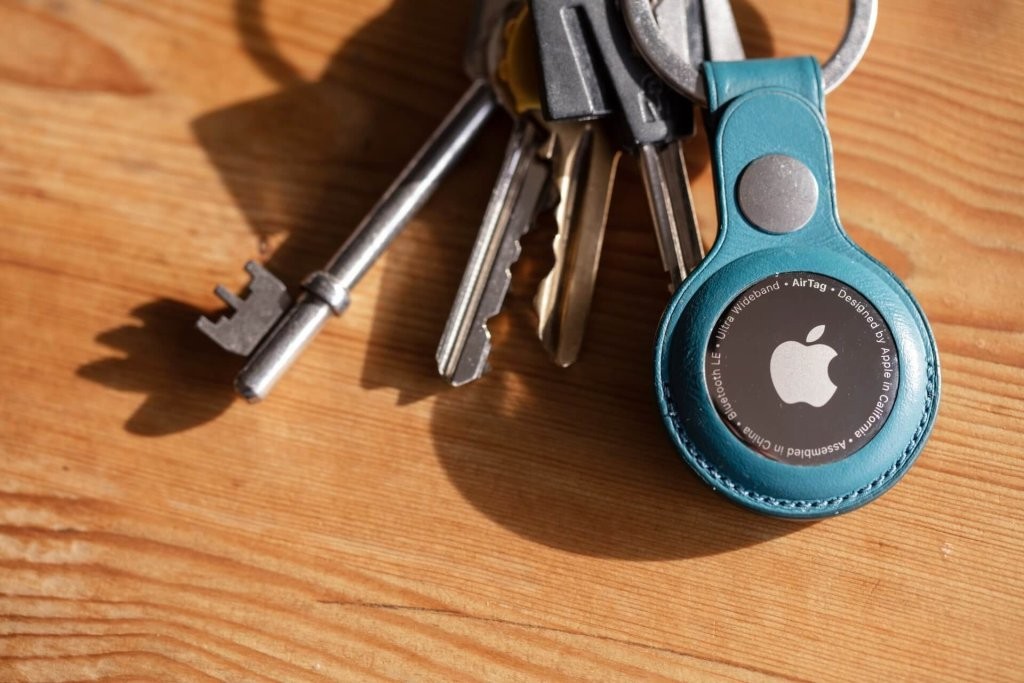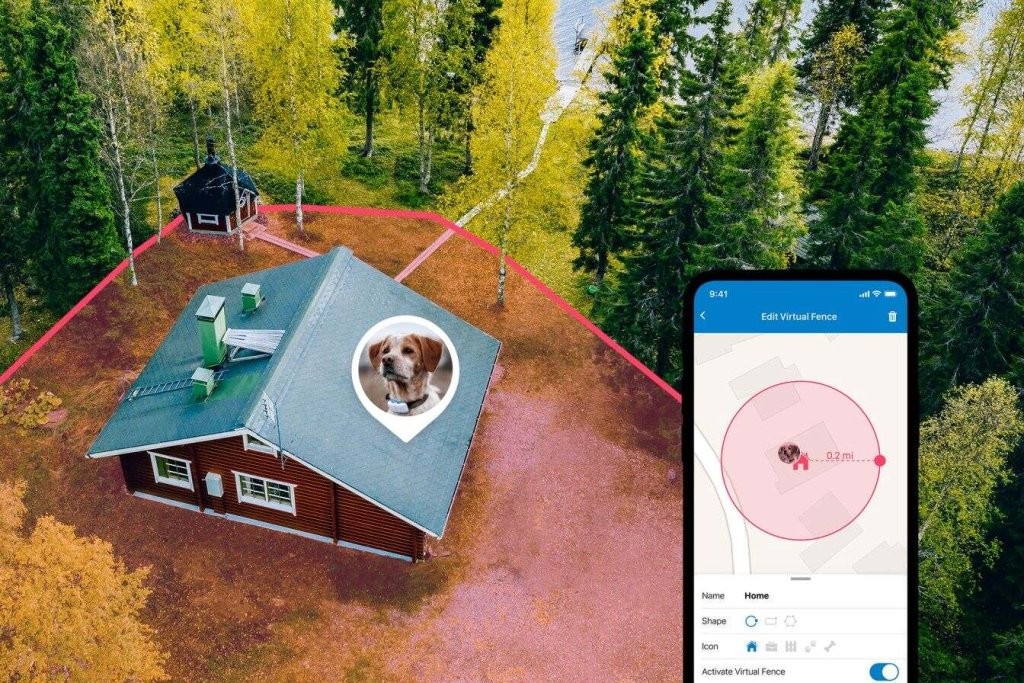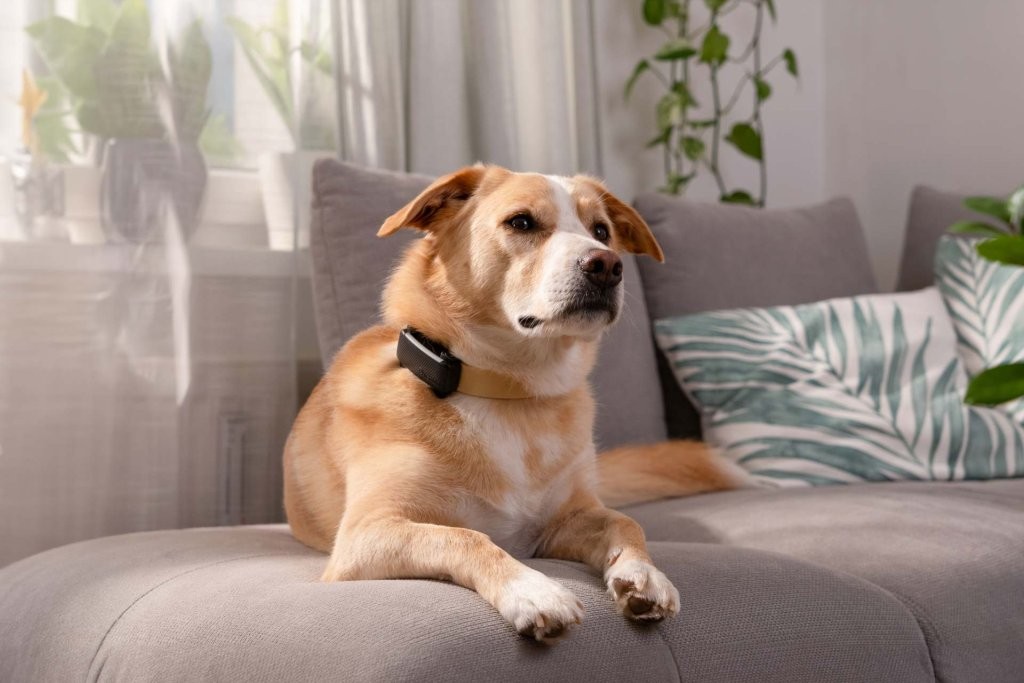Are you considering using AirTags to monitor your beloved pets? At PETS.EDU.VN, we understand the importance of ensuring your pet’s safety. While AirTags can help track items, their effectiveness for pets is limited due to their reliance on the Apple network. Explore reliable alternatives like GPS trackers for real-time location monitoring and added safety features.
This article delves into AirTag functionality, pet tracking limitations, and GPS alternatives for comprehensive pet safety.
1. Understanding AirTags: How Do They Function?
Apple AirTag is a compact tracking device designed to help users locate everyday items such as keys, wallets, and luggage. Attach an AirTag to an object, and you can monitor its location using Apple’s Find My app.
1.1. Key Features of AirTags
- Bluetooth Connectivity: AirTags use Bluetooth to connect with nearby Apple devices, which help determine their location.
- Find My App Integration: Location information is displayed in Apple’s Find My app, allowing users to see the last known location of their tagged items.
- Lost Mode: If an item is lost, users can enable Lost Mode, which notifies them when another Apple device detects the AirTag.
1.2. Limitations of AirTags for Pet Tracking
While AirTags are excellent for tracking inanimate objects, they have significant limitations for pet tracking:
- No GPS: AirTags do not have built-in GPS, so they cannot independently track locations. They rely on nearby Apple devices to report their location.
- Limited Range: AirTags only update their location when near an Apple device. This means if your pet wanders off and is not close to an iPhone, iPad, or Mac, you won’t receive location updates.
- No Real-Time Tracking: AirTags provide the last known location, not real-time tracking. This delay can be critical when trying to find a lost pet quickly.
2. Why AirTags Are Great for Items But Not Ideal for Pets
AirTags excel at tracking items because these objects typically stay within areas with Apple devices. However, pets are mobile and can quickly move out of range, making AirTags less reliable for their safety.
2.1. Scenarios Where AirTags Fall Short
Imagine your dog escapes during a walk in a rural area with few Apple users nearby. An AirTag would be unable to provide location updates until your dog comes within range of an Apple device, which may be too late.
2.2. The Need for Real-Time Tracking
For pet safety, real-time GPS tracking is essential. It provides continuous location updates, allowing you to quickly locate your pet no matter where they are.
3. The Problems With Using AirTags for Dog Tracking
AirTags were not designed for tracking pets, and their limitations can pose risks to your dog’s safety.
3.1. Lack of Real-Time Tracking
AirTags only update when near an iPhone, leading to delayed location updates if your dog runs away.
3.2. Limited Tracking Range
If no Apple devices are nearby, you won’t be able to track your dog at all. This is especially problematic in rural or less populated areas.
3.3. No Escape Alerts
You won’t be notified if your dog runs off. You’ll only find out when you manually check the Find My app.
3.4. Safety Concerns
AirTags are not waterproof or chew-proof, and they can be a health hazard if swallowed.
3.5. Real User Experiences
Many users have reported issues with AirTags not updating their pet’s location consistently. For example, one user on Apple’s Support Community forum noted that their iPhone wouldn’t pick up their dog’s AirTag when leaving home.
4. Real Stories: Why Dog Parents Switch from AirTag to GPS Trackers
Many pet owners have found that while AirTags are useful for items, they don’t provide the reliability needed for pet tracking. Here are a few real stories from pet parents who switched from AirTags to GPS trackers like Tractive.
4.1. Husky Saved by GPS Tracker in the Forest
A Husky owner from Great Britain shared, “My Husky can set off really fast – without Tractive I would never be able to find him. I use the live feature as it updates constantly. Previously I used an AirTag, however it never had a signal in the forest. Now, with Tractive, I can track wherever he is when we are both exploring together.”
4.2. Peace of Mind for a Golden Retriever Family
Lindsay from the United States recounts, “Our adventurous Golden Retriever Oliver is allowed to roam our 20 acres, but we were worried about him roaming too far. We tried an Airtag first, but it has to be near an Apple product to be effective, so that didn’t work. So we tried Tractive and it works awesome! In the app we can see exactly where Oliver is anywhere on our property. And the crazy thing is, most cell networks don’t work very well in our area, but Tractive still works all the time. We are so happy with this product.”
These stories highlight the importance of real-time tracking and reliable coverage, especially in situations where pets roam freely or in areas with limited Apple device presence.
5. What is a GPS Dog Tracker?
A GPS dog tracker is a device specifically designed for pet safety. It uses GPS, cellular networks, and a built-in SIM card to provide real-time location tracking.
5.1. How GPS Trackers Work
Unlike AirTags, GPS dog trackers work anywhere with cellular coverage, providing continuous location updates.
5.2. Additional Features of GPS Trackers
- Real-Time Tracking: GPS trackers provide live location updates, allowing you to see your pet’s exact location at any time.
- Virtual Fences: You can set up safe zones and receive instant alerts if your pet wanders outside these areas.
- Activity Monitoring: Many GPS trackers also monitor your pet’s activity levels, helping you ensure they stay healthy and active.
6. Top Reasons to Choose a GPS Dog Tracker Over AirTag
GPS dog trackers offer several advantages over AirTags when it comes to pet safety.
6.1. Real-Time GPS Tracking
Real-time tracking ensures you can find your runaway dog quickly, preventing them from getting lost in the first place.
6.2. Unlimited Range Tracking
GPS trackers offer unlimited range by using a built-in GPS and integrated SIM card to connect to cellular networks worldwide.
6.3. Escape Alerts
Virtual Fence feature allows you to set up safe zones and receive instant alerts if your dog wanders too far.
6.4. Durable and Waterproof Design
GPS dog trackers are built to withstand the wear and tear of active pets, with waterproof and adventure-proof designs.
6.5. Health and Activity Monitoring
GPS trackers help you track daily activity and rest, spot early signs of health issues, and set fitness goals.
7. The Right Dog Tracker Can Save Your Dog’s Life
Equipping your dog with a reliable GPS dog tracker can literally save their life. These devices offer features and reliability that AirTags simply cannot match.
7.1. Real-Life Examples
There are numerous stories of dogs whose lives were saved by GPS trackers, highlighting the importance of real-time tracking and escape alerts.
7.2. Additional Features to Consider
Beyond the core tracking functions, some GPS trackers offer additional benefits that can enhance your pet’s safety and well-being:
- Activity Monitoring: Track your pet’s daily activity levels to ensure they get enough exercise.
- Sleep Tracking: Monitor your pet’s sleep patterns to identify potential health issues early.
- Customizable Alerts: Set up personalized alerts for various events, such as when your pet leaves a designated safe zone.
- Two-Way Communication: Some trackers even allow you to speak to your pet through the device, providing reassurance from a distance.
8. Exploring GPS Dog Tracker Options
When choosing a GPS dog tracker, consider factors like battery life, coverage area, and additional features. Some popular options include:
| Feature | Tractive GPS Dog Tracker | Whistle Go Explore | Fi Smart Dog Collar |
|---|---|---|---|
| Real-Time Tracking | Yes, with updates every 2-3 seconds in Live Mode | Yes, with updates every minute or every 15 seconds in fast update mode | Yes, with updates every 2 minutes, or every minute in lost dog mode |
| Range | Unlimited worldwide via cellular coverage | Nationwide via AT&T cellular network | Nationwide via AT&T cellular network |
| Battery Life | Up to 10 days, depending on usage | Up to 20 days | Up to 3 months, depending on usage |
| Activity Tracking | Yes, tracks active time, rest, and calories burned | Yes, tracks activity levels, distance traveled, and calories burned | Yes, tracks steps, distance, and sleep |
| Virtual Fence | Yes, with instant escape alerts | Yes, with customizable safe zones | Yes, with customizable safe zones |
| Waterproof | Yes | Yes | Yes |
| Additional Features | Health alerts, location history, separation anxiety monitor, bark monitoring, walks | Medication reminders, vet reports, 24/7 live chat with veterinary experts | LED light for nighttime visibility, lost dog mode, social features |
| Subscription | Required for cellular connectivity, starting at $4.99/month | Required for cellular connectivity, starting at $7.99/month | Required for cellular connectivity, starting at $9.95/month |
| Price | Device cost: Approximately $49.99 – $79.99 (plus subscription) | Device cost: Approximately $129.95 (plus subscription) | Device cost: Approximately $149 (plus subscription) |
| User Reviews | Generally positive reviews for accuracy and reliability, but some users report occasional connectivity issues | Mixed reviews, with some users praising the activity tracking features, while others report inaccuracies in location data | Positive reviews for design and battery life, but some users report issues with GPS accuracy in certain areas |




8.1. Tractive GPS Dog Tracker
Offers real-time tracking with updates every 2-3 seconds, virtual fences, and activity monitoring.
8.2. Whistle Go Explore
Features activity tracking, safe zones, and access to veterinary experts.
8.3. Fi Smart Dog Collar
Includes a long battery life, LED light for nighttime visibility, and lost dog mode.
9. Making an Informed Decision
Choosing the right tracking device for your pet depends on your specific needs and circumstances. Consider the following factors:
- Location: If you live in an area with limited Apple device density, a GPS tracker is a better choice.
- Activity Level: If your pet is highly active and prone to wandering, real-time tracking and escape alerts are essential.
- Budget: GPS trackers typically require a subscription for cellular connectivity, so factor this into your budget.
10. PETS.EDU.VN: Your Partner in Pet Safety
At PETS.EDU.VN, we are committed to providing you with the information and resources you need to keep your pets safe and healthy.
10.1. Expert Advice and Resources
Explore our website for more articles, guides, and product reviews to help you make informed decisions about pet care.
10.2. Trusted Services and Products
We partner with trusted providers of pet care products and services, ensuring you have access to the best options for your furry friends.
10.3. Contact Us
If you have any questions or need personalized recommendations, don’t hesitate to reach out to us.
- Address: 789 Paw Lane, Petville, CA 91234, United States
- WhatsApp: +1 555-987-6543
- Website: PETS.EDU.VN
11. The Bottom Line on Using AirTags for Dogs
While AirTags have their uses, they are not a reliable solution for pet tracking. A dedicated GPS dog tracker offers the real-time tracking, unlimited range, and additional features you need to keep your pet safe.
11.1. Investing in Your Pet’s Safety
Choosing a GPS dog tracker is an investment in your pet’s well-being, providing peace of mind and ensuring you can always find them when they need you most.
11.2. Consider Microchipping Your Pet
In addition to GPS tracking, microchipping your pet is a vital step in ensuring their safe return if they ever get lost. A microchip is a small, electronic chip, about the size of a grain of rice, that is implanted under your pet’s skin. Each microchip has a unique identification number that can be read by a scanner.
When a lost pet is found and taken to a vet or animal shelter, one of the first things they do is scan for a microchip. If a microchip is detected, the identification number is used to locate the pet owner’s contact information in a registry database.
Key Benefits of Microchipping:
- Permanent Identification: Unlike collars and tags that can fall off or be removed, a microchip is a permanent form of identification.
- Increased Chances of Reunification: Microchipped pets are much more likely to be reunited with their owners than those without microchips.
- Peace of Mind: Knowing that your pet has a microchip provides peace of mind that they can be identified and returned to you if they ever get lost.
Important Steps After Microchipping:
- Register Your Pet: Make sure to register your pet’s microchip with a reputable registry service and keep your contact information up to date.
- Update Your Information: If you move or change your phone number, be sure to update your contact information in the registry database.
- Check the Microchip Annually: During your pet’s annual vet visit, ask your veterinarian to scan the microchip to ensure it is still working properly.
12. FAQs: AirTag for Dogs
12.1. What are the pros and cons of using AirTag for dog tracking?
Most people are drawn to the idea of using Apple AirTag for dog tracking because they’re:
- Small & lightweight
- Cheap
- Have a long battery life
But in addition to the pros, AirTags have some important downsides you need to consider before you put one on your dog’s collar:
Pros
- Easy to use
- Small & lightweight
- Long battery life (up to 1 year)
- Works great in areas where Apple users are nearby
- Affordable
- Free personalization
Cons
- No GPS live tracking
- Swallow hazard for your dog
- Won’t work out of Bluetooth range of an Apple device
- Not designed for tracking pets
- No pet-friendly features, like Virtual Fences or Health Alerts
12.2. How does AirTag work for dogs?
If you were to try AirTag for dog tracking, here’s how that would work:
- Buy an AirTag and connect it to your Apple device.
- Attach the AirTag to your dog’s collar or harness.
- AirTag sends out a signal that gets picked up by Apple devices within range. They send their location along with the AirTag’s identifying data to Apple servers.
- When you need to locate your dog, you can open the Find My app and (in the best-case scenario) view your dog’s location.
- If necessary, you can “Ping” the AirTag – it will make a sound that helps you find it.
12.3. Are there any health risks associated with using AirTags on pets?
Yes, AirTags can pose a health risk to pets if they are chewed or swallowed. The small size of the AirTag makes it a potential choking hazard, and the battery inside can be harmful if ingested.
12.4. Can I use AirTags to track other types of pets besides dogs?
While it’s possible to attach an AirTag to other pets, such as cats, the same limitations apply. The lack of real-time tracking and reliance on the Apple network make it less reliable for any pet that may wander out of range.
12.5. What should I do if my pet swallows an AirTag?
If you suspect that your pet has swallowed an AirTag, it is crucial to seek immediate veterinary attention. The battery inside the AirTag can cause serious internal damage if ingested.
12.6. How much does a GPS dog tracker cost compared to an AirTag?
GPS dog trackers typically have a higher upfront cost compared to AirTags. However, they offer more reliable tracking and additional features specifically designed for pet safety.
| Tracking Device | Initial Cost | Subscription Fee |
|---|---|---|
| Apple AirTag | $29 | None |
| Tractive GPS Dog Tracker | $49.99 – $79.99 | Starting at $4.99/month |
| Whistle Go Explore | $129.95 | Starting at $7.99/month |
| Fi Smart Dog Collar | $149 | Starting at $9.95/month |
12.7. How can I improve the accuracy of an AirTag if I choose to use it for my pet?
To improve the accuracy of an AirTag for pet tracking, ensure that your pet spends time in areas with a high density of Apple devices. However, keep in mind that this is not a reliable solution for real-time tracking or escape alerts.
12.8. What are the best practices for attaching an AirTag to my pet’s collar?
When attaching an AirTag to your pet’s collar, use a secure holder or case that prevents it from falling off or being easily chewed. Regularly check the attachment to ensure it is still secure.
12.9. Are there any alternatives to AirTags and GPS trackers for pet tracking?
Yes, there are other types of pet trackers available, such as Bluetooth trackers and radio frequency (RF) trackers. However, these options also have limitations in terms of range and accuracy compared to GPS trackers.
12.10. How do I choose the right GPS dog tracker for my pet?
When choosing a GPS dog tracker, consider factors such as battery life, coverage area, accuracy, durability, and additional features like activity monitoring and virtual fences. Read reviews and compare different models to find the best fit for your pet’s needs.
13. Conclusion: Ensuring Your Pet’s Safety
In conclusion, while AirTags can be useful for tracking inanimate objects, they are not the best choice for tracking pets. The lack of real-time tracking, limited range, and potential safety hazards make them less reliable than dedicated GPS dog trackers.
At PETS.EDU.VN, we encourage you to prioritize your pet’s safety by investing in a GPS dog tracker that offers real-time tracking, unlimited range, and additional features designed specifically for pet well-being. Contact us at pets.edu.vn, located at 789 Paw Lane, Petville, CA 91234, United States, or WhatsApp us at +1 555-987-6543 for personalized recommendations and expert advice. Your pet’s safety is our top priority.